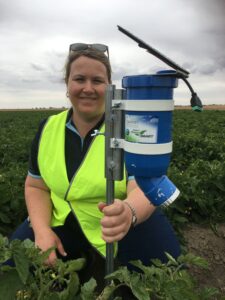WaterWise technology saves on water and delivers higher yields

Australian company Goanna Ag will make its GoField water management solution commercially available in the U.S. from 1 June. Goanna Ag is currently trialling the system in the U.S. in collaboration with the USDA Agricultural Research Service.
The WaterWise technology of Australian Research Organisation CSIRO is incorporated into Goanna Ag’s GoField. This water-use efficiency product for irrigated crops measures crop water stress and predicts future water needs in real time.
Data of Goanna Ag has shown that some growers could save 20% to 40% on water and can achieve 10% to 40% yield improvement through reduced plant stress.
The cooperation of CSIRO and Goanna Ag has led to a rapid growth of the technology in Australia. CEO Alicia Garden of Goanna Ag says that since then 40% of the Australian cotton crop has been irrigated using GoField.
Expanding and testing in new crops
WaterWise-lead Dr Rose Roche at CSIRO says that Goanna Ag currently has trials in corn and cotton in the United States. Trials are now in their third year and showing significant benefit. CSIRO also has trials in tree crops in Australia.
“Together we’re evaluating commercial fields, using the technology in cotton in Australia and the U.S.”, Dr Roche points out. “We’re also expanding and testing in new crops, for example almonds and wine grapes.”
In-field sensors

The technology ‘lets the plants do the talking’ with in-field sensors that measure the canopy temperature of crops every 15 minutes. The system sends the data to sensor data infrastructure, adds in the weather forecast and uses machine learning to apply CSIRO’s algorithm to predict the crop’s water requirements for the next seven days.
The technology is especially valuable for high-value crops. The users of the technology are primarily individual irrigation farmers.
Growers can see the water stress of their crops at any point and predict their future water needs
Dr Roche explains that predicting the future is real breakthrough-science. “It means growers can see the water stress of their crops at any point and predict their future water needs.” The technology allows farmers to plan, based on what the plant needs.
According to Dr Roche, just like humans, plants have an optimum temperature. “When things are normal it’s easier to predict when a plant will need water. But when conditions change – like with a new crop, a new field, or unusually hot or cold weather forecasted – farmers want back-up with their decision making.”
Every drop counts
Dr Roche says that the usual strategy for growers is often ‘if you‘re unsure, just add water’. “This is where using high tech can help give them data and more confidence in their decision making, because every drop counts.”
According to a recent case study report, the technology has the potential to benefit the Australian agriculture sector, with the most notable impact on the most water-intensive agricultural commodities and other farming operations that rely on flood irrigation practices.
Three adoption scenarios
The report presents a case study that evaluated three adoption scenarios (low, medium, and high) of the technology for four high-value crops (cotton, sugarcane, tomatoes, and almonds). Each scenario results in different economic impacts because of each scenario’s projected reduction in costs and increase in yields.
Under the low scenario, it was assumed that a 30% penetration rate is achieved, 50% under the medium scenario, and 70% under the high scenario. Approximately 70% of farms use some type of irrigation management system, which is a conservative upper bound for our scenarios. According to the study, realistically, given the range of expected water savings benefits, a high penetration is plausible.
Between 179 and 2,476 thousand megalitres water saved
The study team found that the technology has the potential to provide between AUS $ 48 million (US $ 33.62 million) and $ 769 million (US $ 538.64) in economic impacts accruing to Australian agricultural producers between 2021 and 2030.
Under the medium scenario, the study estimates the present value of impacts to range between $ 180 and $ 346 million. The associated water savings driving the economic impact results ranged between 179 and 2,476 thousand megalitres over the 10-year period. These results are limited to only four of the most water-intensive agricultural commodities – cotton, sugarcane, tomatoes, and almonds.
Confidence in irrigation decision-making
The case study says that Improved water use efficiency will result in water savings that could enable industries to increase crop area or yield, and also increase revenues. Growers can gain confidence in irrigation decision-making. This can enable them to minimise risk and seasonal variability, as well as become more resilient to climate-related hazards and extreme events.
The technology further delivers the co-benefits of greenhouse gas emissions reductions that can be achieved from reduced energy consumption for irrigation pumping due to decreased water use. Indirect co-benefits are likely for other sectors from the reduction in agricultural water use and demand.
Join 17,000+ subscribers
Subscribe to our newsletter to stay updated about all the need-to-know content in the agricultural sector, two times a week.



